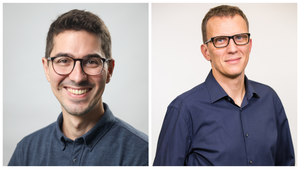In 2014, I started Labiotech.eu because I felt Europe’s biotech industry deserved better media, more connected, faster, and more independent. A decade later, I find myself back where it all began: trying to strengthen biotech journalism in Europe once again.
This time, though, I’m not starting from scratch.
Together with my business partner, Michael Kuhrt, I’ve acquired BIOCOM Interrelations GmbH, the company behind transkript and European Biotechnology Magazine. It’s one of the oldest and most respected names in European biotech media, and we’re incredibly proud to continue its story.
Why BIOCOM?
If you’ve worked in European biotech for a while, you’ve probably come across transkript or European Biotechnology Magazine. They’ve been fixtures of the industry for decades, the kind of publications that have quietly chronicled its evolution long before “biotech” became a buzzword.
At this point, BIOCOM isn’t just a publisher, it’s a piece of the ecosystem’s DNA.
The company runs two flagship magazines and several annual guides that map the industry’s players across biotech and medtech:
- transkript covers the German biotech landscape, in German, and remains one of the few national outlets dedicated to this industry.
- European Biotechnology Magazine is its English-language counterpart, giving a broader, continental perspective.
- The European Biotechnology Guide, European Medtech Guide, and German Biotechnology Guide are invaluable directories that have helped connect companies, investors, and researchers for years.
What makes BIOCOM special is its continuity. While other publications pivoted, disappeared, or narrowed their focus, BIOCOM kept publishing, steady, reliable, and deeply embedded in the European biotech scene.
When the opportunity arose to acquire it, I saw it as a chance to protect something meaningful and help it evolve.
The backstory: From competitors to collaborators
This story actually started years ago.
When I launched Labiotech.eu in 2014, European Biotechnology Magazine was one of our main competitors. Back then, it was print-first, while we were an online-only publication trying to shake things up. We were two very different media approaches serving the same mission: to tell Europe’s biotech story.
In 2022, Labiotech was acquired by Inova (now In-part) and the publication went global, broadening its editorial coverage beyond Europe, which, in my view, left a gap. European Biotechnology Magazine became once again the only independent biotech media dedicated solely to the European industry.
That thought stayed with me.
Meanwhile, Michael — my new business partner — had his own history with BIOCOM. He spent many years working inside the company before leaving six years ago to explore new ventures in AI and consumer publishing. When we reconnected, the idea came naturally: what if we combined our complementary experiences — his insider knowledge and my digital media background — to bring BIOCOM into a new era?
Why we decided to buy it
For both of us, this acquisition is personal.
We’re not financial investors looking for a quick return. We’re builders and storytellers. We believe that quality journalism matters, especially in science. The biotech industry is full of complex ideas, groundbreaking research, and ethical debates that deserve clear, independent reporting.
Europe has brilliant biotech scientists and entrepreneurs, but its media landscape is fragmented, and few publications connect the dots across borders.
BIOCOM already has the credibility and reach to do that, it just needs to evolve for the digital age. That’s what we plan to do.
For us, that means maintaining the respected print editions of transkript and European Biotechnology Magazine while pairing them with a stronger digital presence, more cross-European coverage, and fresh editorial formats.
What we’re bringing to the table
As part of this new chapter, we’re also merging two of my ventures — The Science Marketer and Biotech Snap — into the BIOCOM portfolio.
Launched in 2023, The Science Marketer began as my personal newsletter and blog about science communication and marketing. Over time, it grew into a small but vibrant community of professionals who care about how science is communicated to the world. It’s both a publication and my own one-man consultancy, helping life-science companies find their voice.
Then, in 2025, I launched Biotech Snap, a daily biotech news briefing built for how people actually consume content today. Short, sharp, and useful. The idea was to help biotech professionals stay informed in five minutes or less, without information overload.
Both projects will now become part of BIOCOM’s media family. My consulting activities will also merge with the existing corporate communication services of BIOCOM and bring even more value to our clients.
That might sound like a small change, but strategically, it’s huge. It means BIOCOM will no longer be just a traditional publisher, it will be a multi-platform media group, blending long-form journalism, daily briefings, and practical insights for marketers and communicators.
In other words, we’re connecting the dots between biotech reporting, industry intelligence, and communication strategy.
The mission that drives us
At the heart of this move is a belief I’ve held for years: good journalism helps industries progress.
When reporting is rigorous, it fosters accountability. When storytelling is compelling, it builds understanding. And when information flows freely, innovation accelerates.
Biotech, perhaps more than any other field, needs this kind of journalism. It’s an industry built on trust between scientists, investors, regulators, and the public. Without clear, independent voices explaining what’s happening and why it matters, that trust can erode.
Our mission is to ensure that doesn’t happen.
We want BIOCOM to be the place where Europe’s biotech stories are told with depth, clarity, and context, and where new voices can emerge. Whether it’s a breakthrough from a university spin-off in Denmark, a new manufacturing hub in Austria, or a bold policy initiative in Brussels, these stories deserve to be heard.
Where we go from here
So, what happens next?
In the short term, nothing dramatic, and that’s intentional. All of BIOCOM’s existing publications will continue as usual in the short term, with the same editorial teams and production schedules. We want to ensure continuity and stability.
Behind the scenes, though, we’ll start working on digital upgrades, modernized design, and new editorial collaborations across Europe.
We’re also exploring ways to bring more interaction between the print and online worlds, for example, linking transkript’s German-language reporting to European Biotechnology Magazine’s international coverage, so readers can seamlessly move between the two.
The first new developments under our leadership will be unveiled in early 2026, and we’re already brimming with ideas.
A personal note
On a personal level, this feels like the most meaningful professional step I’ve taken since founding Labiotech. It combines everything I care about: biotech, media, storytelling, and the belief that communication can accelerate progress.
I also see this as a way to give back to the ecosystem that shaped my career. So many of the opportunities I’ve had — from running Labiotech to launching The Science Marketer and Biotech Snap — came from the vibrant biotech community in Europe. Taking responsibility for one of its oldest media companies feels like a full-circle moment.
If you’ve followed my journey so far through Labiotech, The Science Marketer, or Biotech Snap, thank you. Your support and feedback are what keep me writing and building.
And if you care about biotech, science communication, or the future of journalism, stay tuned. This new chapter is just beginning.





